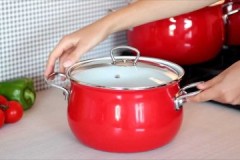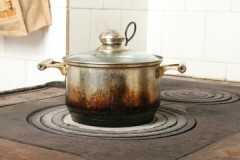Useful life hacks on how to remove carbon deposits from a gas stove grate at home
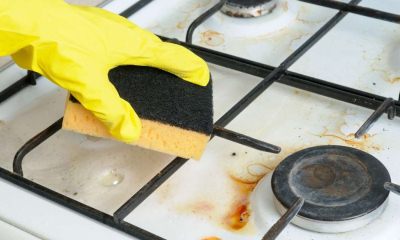 Drops of fat, soot, food particles that settle on the grate bars during the cooking process - all this eventually turns into a dense layer of carbon deposits, which is very problematic to get rid of.
Drops of fat, soot, food particles that settle on the grate bars during the cooking process - all this eventually turns into a dense layer of carbon deposits, which is very problematic to get rid of.
It is possible to simplify the cleaning process as much as possible, to achieve the desired result of the shining grids of the gas stove can only be provided with the correct method and detergent composition.
How to clean the grate of a gas stove from carbon deposits at home, we will tell you in the article.
Content
How to remove folk remedies?
You should start cleaning the gas stove grates with the available tools at hand (we save money and time spent on buying household chemicals).
Soda
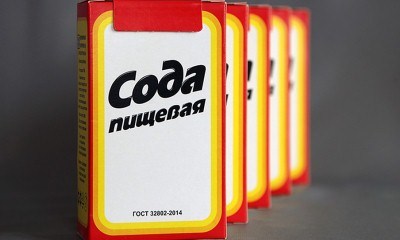 Dry baking soda powder is a natural abrasive that perfectly cleans steel and cast iron rods.
Dry baking soda powder is a natural abrasive that perfectly cleans steel and cast iron rods.
Algorithm of actions:
- the baking soda is diluted to a thick paste;
- the finished product is applied to the wire rack and left for thirty minutes;
- the treated surfaces are thoroughly rubbed with a brush or hard washcloth, and then washed off with warm water.
The baking soda paste is best applied to the slightly damp surface of the twigs.
Mustard
Fresh mustard or dry mustard powder is a gentle soot cleaner for grates (does not leave scratches or scuffs).
Algorithm of actions:
- The grate is thoroughly wiped with a damp cloth.
- Dry mustard is diluted with water to form a thick paste.
- The prepared mixture is applied to each rod and left for at least three hours.
- The treated surfaces are carefully wiped with a rag, hard sponge or brush.
It is not necessary to dilute fresh mustard with water before applying it to the wire rack.
Laundry soap and stationery glue
The product, the effectiveness of which has been tested by time, is a mixture of soap and office glue.
Algorithm of actions:
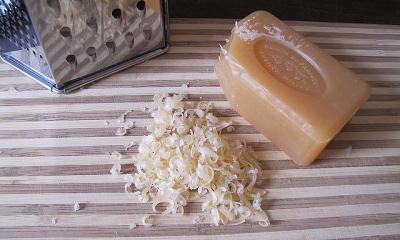 ten liters of water are poured into a bowl or large saucepan, in which 150 ml of office glue and a bar of laundry soap grated on a coarse grater are stirred;
ten liters of water are poured into a bowl or large saucepan, in which 150 ml of office glue and a bar of laundry soap grated on a coarse grater are stirred;- put the prepared saucepan on fire and bring its contents to a boil;
- I dip dirty grates into boiling water, and continue the boiling process for another hour;
- after sixty minutes, the pan is removed from the heat, the grates are taken out, each rod is cleaned with a cruel sponge or brush;
- the already cleaned surface is washed again under warm running water.
During boiling, make sure that the grate is completely immersed in water. The boiled liquid is topped up as necessary.
Use of household chemicals
Special chemical compounds designed to remove stubborn fat deposits, carbon deposits and soot will quickly return the gas stove grate to its original appearance. A wide range of household chemicals is presented on the shelves of hardware stores.
Gels are gently washed from fat, do not leave scratches, ideal for any material. When choosing a cleaning spray, it is necessary to carefully study the composition (a high concentration of acids and alkalis is dangerous for cast-iron and enameled surfaces). The rest of the spray is very convenient to use, it helps to save money by spraying it onto the surface through a special spray bottle.
TOP - the most effective means of removing carbon deposits from the grate of a gas stove:
Top House Grease Purifier
It will dissolve without residue:
- frozen fat
- soot,
- burnt food.
The polishing microgranules in the composition of the spray will restore the original gloss of the gas stove grate. After using the spray, a protective film forms on the surface, facilitating subsequent cleaning.
Convenient spray bottle helps to save cleaning agent consumption. The average cost is 400 rubles. (500 ml bottle).
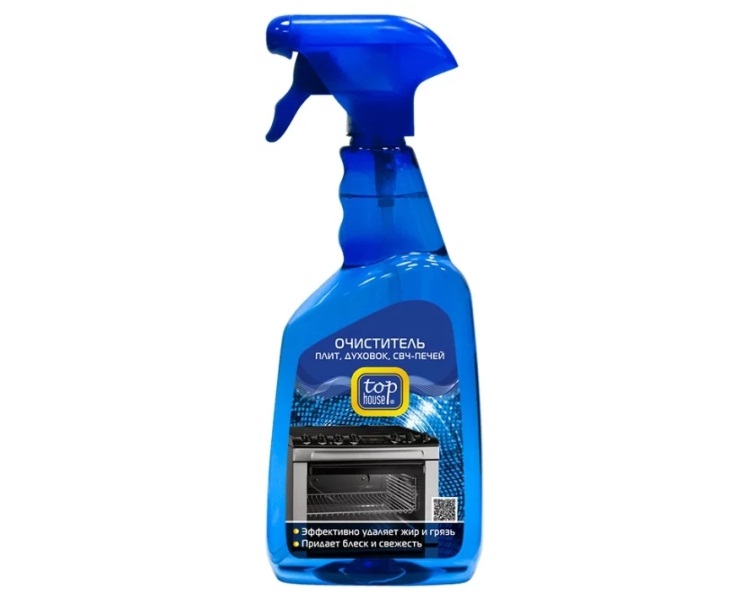
Mister chister
Removes stubborn grease, soot and carbon deposits from the gas stove in just three minutes... It is enough to spray the composition on the contaminated surface, wait a little and rinse with warm water. The average cost is 220 rubles. (500 ml bottle).
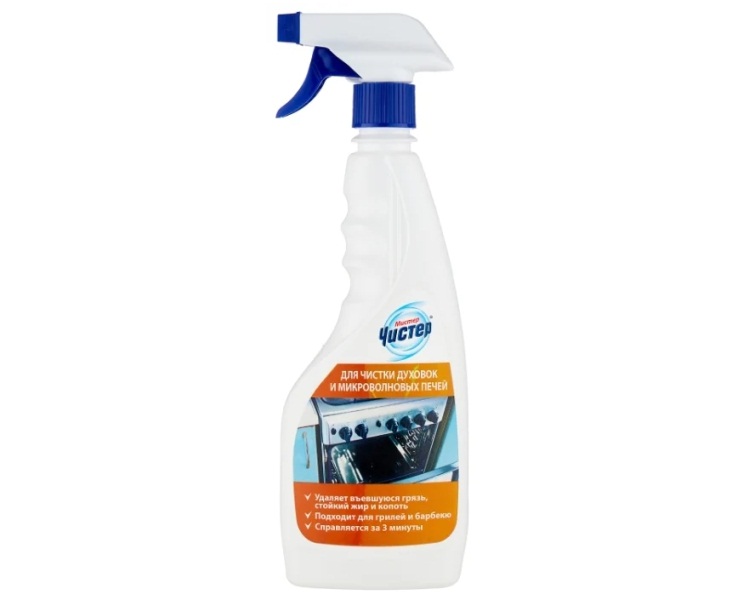
Spray grease remover Sanita
The product of a Russian manufacturer is suitable for removing particularly difficult contaminants (fat, soot, burnt food). Recommended for processing gas stove grates and other kitchen surfaces from:
- become,
- cast iron,
- enamels,
- stainless steel.
It is enough to spray the product on the dirt, wait one minute, rinse with warm water. Average cost - 170 rubles. (500 ml bottle).
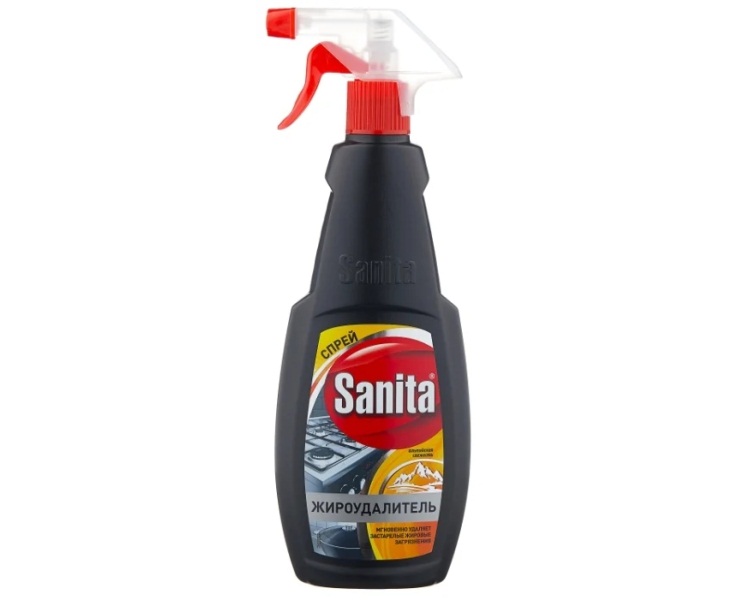
It is possible to work with household chemicals only after a detailed study of the manufacturer's instructions, in a well-ventilated area, using protective rubber gloves.
Heat treatment
Roasting metal with an open fire (calcining or heat treatment) is a great way quickly clean the steel grates of the gas stove from dense layers of carbon deposits. This cleaning cannot be used for cast iron or enamel rods.
Steam treatment
Steam cleaning is a great way to clean your cast iron grate.
Algorithm of actions:
- Place a baking sheet with water in the oven.
- After heating the oven to a temperature of 120 ° C, a dirty grate is lowered into a baking sheet with water.
- After half an hour, the softened layers of fat are easily cleaned off with a brush or sponge.
Alternatively, the steam treatment can be carried out using a household steam generator.
Metal brush
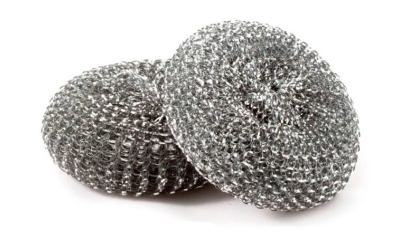 Hard cleaning with metal brushes is suitable when the grill on the gas stove is non-separable.
Hard cleaning with metal brushes is suitable when the grill on the gas stove is non-separable.
Algorithm of actions:
- the rods are moistened with water;
- using a stiff metal brush, scrape off dirt with active circular motions;
- wipe the cleaned surface with a clean damp cloth.
You can simplify the mechanical cleaning process if you use a drill with a special brush attachment.
Cleaning features depending on the material
The first thing to do when starting to clean the gas stove grate is to find out what material it is made of. This knowledge directly influences the choice of cleaning method and type of detergent.
Cast iron
Cast iron rods are very moody to care for... Cast iron scratches very easily. Therefore, such products cannot be scraped with a knife or other sharp objects, or soot must not be beaten off the surface with a hammer. Cast iron does not withstand the aggressive effects of acid compounds.
Stainless steel
The stainless steel grates are resistant to chemical and abrasive substances. It is easy to clean the stainless steel from carbon deposits using a metal brush, sanding or soda. It is enough to slightly moisten the metal with water, and then thoroughly rub the dirt.
Enamel
 Lightweight lattices covered with enamel are sensitive to rough mechanical and aggressive chemical attack.
Lightweight lattices covered with enamel are sensitive to rough mechanical and aggressive chemical attack.
The method of soaking in soapy water will help remove carbon deposits from such surfaces.... Dissolve 100 ml of liquid dishwashing liquid in 10 liters of water.
In the resulting composition, the pan is soaked for at least six hours, after which the dirt can be easily cleaned off with a soft brush or sponge.
How to prevent plaque formation?
In order for the grill of the gas stove to always shine clean, the following rules must be observed:
- Cleaning - after every cooking... It couldn't be easier to wipe down the grate with a damp cloth at the end of the day. Taking two minutes of regular cleaning will save you two hours removing stubborn grease and grime.
- Chip-free surface - less dirt... The fewer scratches, scuffs and chips on the gas grate, the easier it is to keep it clean.
Advice
A few tips from experienced housewives will ease the difficult process of cleaning gas grids from carbon deposits:
- Fresh carbon deposits can be easily removed with lemon juice. It is enough to wipe the twigs with a slice of fresh citrus and there will be no trace of greasy stains.
- Soaking time in soapy water should not exceed six hours. Prolonged contact with water destroys the protective layer of the metal rods.
- Liquid for washing car engines - an effective tool in the fight against carbon deposits on cast iron grates.
Life hack: using dishes with high sides helps to keep the grids and the working surface of the gas stove clean.
Methods and means of cleaning various surfaces from carbon deposits are presented in given section.
Related videos
How to clean the grate of a gas stove, the video will tell you:
Conclusion
Timely cleaning using the right detergents will help you forget about the problem of carbon deposits on the gas stove grates forever.

